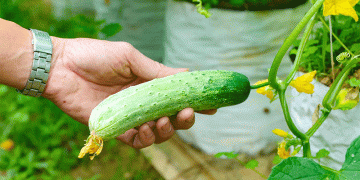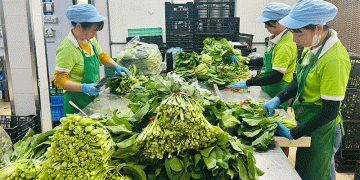Chlorine is a commonly used tool of the fresh-cut produce industry to prevent cross-contamination in the wash flume. But a high organic load, as is common in fresh-cut produce, reduces the efficacy of chlorine by using up free chlorine. A new chlorine stabilizer called SmartWash from New Leaf Food Safety Solutions, Salinas, Calif., could improve food safety during the wash and transport through the cutting room.
SmartWash is a chlorine stabilizer made from Generally Recognized As Safe ingredients, and complies with FDA produce-wash guidelines. It is a substitute for citric acid to adjust the pH of the wash solution to the desired level, typically 3.5-5.5. The equipment is easily added inline, and is currently employed in Taylor Farms’ leafy green lines. New Leaf and Taylor Farms are owned by the same parent company, Taylor Fresh Foods.
The technology showed positive results, but the company wanted more verification of the benefits, so it was submitted to USDA researchers. A research proposal was funded by the Center for Produce Safety at the University of California, Davis, for further study on SmartWash by researchers Sunny Luo, Xiangwu Nou, Patricia Milner and Daniel Shelton at USDA’s Environmental Microbial and Food Safety Laboratory, Beltsville, Md.
The research has looked at the use of SmartWash (called T-128 in the study) in lettuce juice at varying amounts and in wash solutions containing soil. In the latter, SmartWash significantly reduced the degradation of free chlorine compared to the control. Efficacy of the stabilizer solution was better with clay soil than with sandy soil, but both were better than the control.
The stabilizer lowers the pH of the wash solution, but the researchers found no remarkable damages on lettuce used in the trials.
“In general, it substitutes for an acid and it can be used to adjust the pH of the solution and can be used to slow down the depletion of free chlorine in solution,” said Patricia Milner, a research microbiologist with USDA.
There were additional bacteriocidal benefits to the SmartWash technology, Milner said. At 2.5 percent, there was significant die-off of pathogen cells after 2-10 minutes in solution. When lettuce juice was added to the wash solution, along with lettuce inoculated with salmonella and two strains of E. coli, there were pathogenic cells that survived on the tissue and in the water at .05 percent, but at 1 percent there was survival on tissue but not in the solution.
“While there still is a decrease of chlorine, there is a decrease of free chlorine used up with T-128,” Milner said.
In control tests, free chlorine was used up quickly in the presence of organic load. When lettuce juice concentration reached 1-2 percent in the solution, free chlorine concentration dropped below .3 parts per million, and pathogen cells were able to survive at those rates. With the SmartWash/T-128 in solution, even at the highest juice concentration (2 percent), free chlorine only dropped to .41 ppm, and no pathogen cells were detected at that level.
The researchers are planning further cross-contamination studies on a larger scale, but based upon the results of this preliminary research, SmartWash/T-128 significantly reduces the depletion of free chlorine, especially in the presence of soil, and to a lesser degree with 1 percent lettuce juice, Milner said. It also reduces cross-contamination of lettuce by and survival of E. coli O157:H7 and salmonella typhimorium, while having no adverse effects on lettuce from the reduced pH of the wash solution.






























